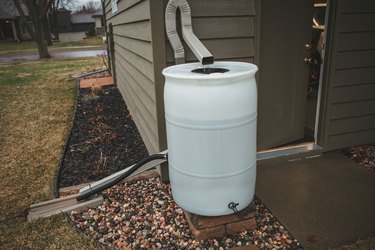Every plant needs water to survive – even desert-dwelling cacti and thorn bushes – but it's also possible to have too much of a good thing. If the soil in your vegetable garden stays too wet for too long, most of your herbs and vegetables aren't going to perform well (and very often will die or struggle with disease). There are some tried-and-true ways to work with poor drainage in a vegetable garden, once you've identified the cause of your problem. Most are simple and relatively inexpensive, though in some cases you'll need to do some serious yard work.
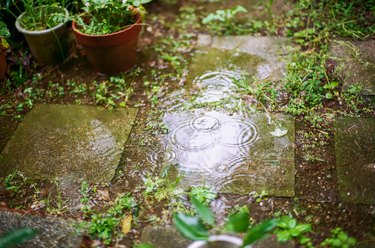
Video of the Day
First, Identify the Actual Problem
Before you grab your shovel and jump in, take some time to assess what the source of your drainage problem actually is. Are there any obvious sources of excess water in your garden, like runoff from your neighbor's new concrete patio, or a downspout on your house that drains to . . . nowhere? Is your vegetable garden located in a naturally low spot of your yard, where water accumulates? Is it just that you have heavy clay soil, or that your soil is badly compacted from foot traffic or machinery?
Video of the Day
The solution to your problem will vary, depending on what you find. If you've unknowingly situated your veggie patch in a soggy, boggy spot, the easiest thing is often simply to move it. If it's a downspout or similar issue on your own property, rerouting it might clear up the problem. Issues of runoff from your neighbor's property are more difficult, and a permanent solution might require some excavation. In many cases you can address your drainage issues simply, so let's look at the alternatives.
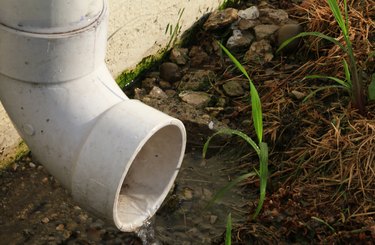
1. Garden in Raised Beds
One of your simplest options is to build raised beds for your vegetables to grow in. You can build your own permanent beds from a variety of materials, order a kit that just needs to be assembled (a great option for people with limited carpentry skills), or just mound up the soil and not even bother with a frame. The important thing is just to raise up the soil where the vegetables will grow. The mounded-up soil will be looser than what lies beneath - even if you've just shoveled the same soil up into a pile - and gravity ensures that excess moisture will drain from the raised beds first. If the soil underneath your raised beds isn't especially good to begin with, you might want to bring in higher-quality topsoil (and maybe some aged compost) to make up your beds, either alone or well mixed with your existing soil.
This doesn't actually fix your drainage problem as such, because the soil beneath your beds will still be sodden for part of the year, but you'll be able to grow vegetables while you save up for a longer-term solution.
Things You'll Need:

2. Trench Between the Beds
Trenching between your vegetable beds could be construed as the opposite of building raised beds – you're lowering the surrounding soil, rather than raising the bed itself – but the net effect is the same: you create an elevated growing area, which allows water to seep away from your plants' roots. You're also providing a channel for that excess moisture to escape, improving drainage around your plants' roots.
It's not rocket science, you're just going to dig a trench between each bed, where you currently have a walkway. Essentially, you're just lowering that walkway by a few inches (4 to 10 inches will do). You'll also need a trench across the bottom of your garden to collect the water and carry it away. If your plot has a gentle slope of its own, use that. Otherwise, make your trenches shallow at one end and deeper at the other - just by a couple of inches - so water will flow naturally. At one corner, you'll need to give that water an escape route: channel it to an existing drain, or through a pipe to your driveway or a ditch, depending on your circumstances. Lining the bottom of the trench with gravel or crushed stone will help minimize erosion and improve your footing as you work in the garden.
Things You'll Need:
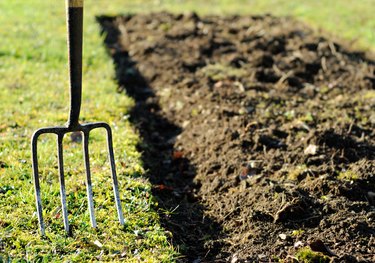
3. Add Sand or Other Inorganic Materials
If you can't find any other obvious reasons for your garden to have drainage issues, usually it boils down to the condition of your soil. It may be compacted from feet or machinery passing over it, or it might simply be a heavy soil with a high clay content. Clay is problematic for plants' roots, because it's made up of silty particles that pack together very tightly. This leaves little room for air or water to percolate through, and makes for a poor growing environment.
One way to address this is through the addition of sand, stone dust or other inorganic materials such as perlite or vermiculite. You'll need to pick a time when your soil is neither sodden nor rock-hard, and sprinkle a layer of your chosen soil amendments over top. Use a mechanical tiller/cultivator or a combination of shovel, fork and heavy garden rake to combine them, breaking up the clods of dirt as best you can. All of these materials are coarser than clay particles and will create air pockets. Perlite and vermiculite are porous and will also trap water, helping draw it from the clay.
Things You'll Need:

4. Add Compost or Other Organic Materials
The other things that's missing from dense, poor-draining soil is organic material. Organic material helps create tilth, that soft, crumbly texture you see in the best soil. There are several of these amendments you can add to your soil. The best include peat, well-aged compost (either homemade or store-bought), aged manure and mulches such as straw or shredded leaves. Mulches are best applied at the end of the season, so they can decompose over the winter, and then be tilled in in the spring to help build up the soil.
Farmers also use something called "green manure" to build their soil, and it's a technique that's useful for gardeners as well. Essentially it means that as you empty your beds at the end of the season, you replant them with a cover crop such as rye, buckwheat, clover, alfalfa or even field peas. These grow up partway before winter arrives, and are dead or dormant come spring. Their root growth will help lighten and break up your soil over the winter, and then you'll till them into the soil in spring where they'll decompose and add both nutrients and organic matter (alfalfa, clover and peas all add valuable nitrogen, as well). Worms will be attracted to the organic material, aerating the soil further and enriching it with their casts (droppings), helping perpetuate a virtuous cycle of soil enrichment. You can speed the process by adding worms directly, in bulk, to your garden beds.
Things You'll Need:
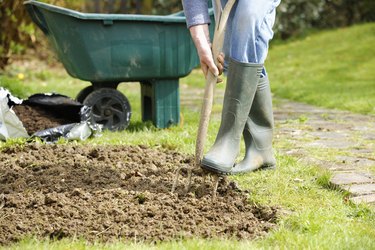
5. Install a Drainage System
In some cases half-measures aren't going to give you a usable vegetable garden: you're going to need to invest the time, money and effort into upgrading your property's drainage. If you've identified a clear source of water coming into the yard, or if your hard has a detectable slope leading to the vegetable garden, a simple French drain might work. You dig a trench across the affected area, between the "upstream" source and your garden, and then line it with gravel and a perforated pipe to drain the excess water away from your garden. You'll need a place for that water to go, otherwise you're just transferring your problem to another location. Routing it to a drain is best if that's an available option, install a catch basin, or you might create a small pond or "water garden" of moisture-loving plants and simply let the water pool as it will.
It's often better (and sometimes cheaper in the long run) to talk to a few landscaping contractors about what should be done to fix your problem permanently. Their experience with the problem at hand, and their knowledge of local bylaws, can save you a lot of expensive trial and error (or even worse, a municipal order to undo what you've done). Remember, poor drainage can cause problems that go well beyond moldy carrots. It can kill your trees, rot fences and decks, cause leaks in your basement, and more. Really fixing the drainage, as opposed to masking it, addresses all of those issues.
Things You'll Need:
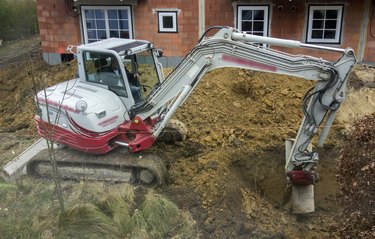
Think It Through Before You Dig
Arguably planning, and thinking things through completely, is the most important part of the process. If your drainage issues are seasonal, for example, your fix may leave you needing to water your vegetables more often later in the year (if the excess water comes from your downspout, installing a rain barrel can help with both of those problems). Similarly, if you're trenching between your beds or installing a French drain, you need to know where that water's going to go.
Draining into a neighbor's property will make you unpopular, and possibly violate local ordinances. Running the water down your driveway to drain into the gutter is sometimes an option (unless it's illegal locally) but can make for an icy, slippery mess in wintertime. An ideal scenario would route the water to where it's actually wanted, perhaps a patch of lawn that needs regular watering. Your best bet is often to talk to the neighbors, and see whether they've had to address similar issues and if so, what they did (and how well it worked). As a rule, the right contractor can make just about anything happen for you: the question is whether you can realistically budget for it.
Things You'll Need:
